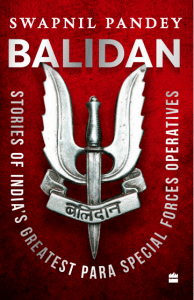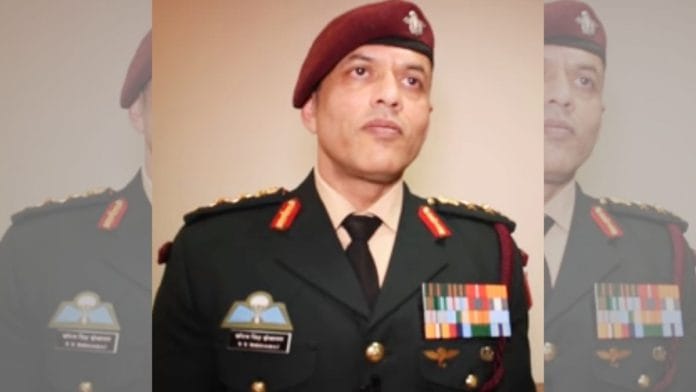Second Lt Shekhawat took his first steps towards the coveted world of the maroon beret, the Balidan Badge and the SF when he was commissioned into 17 Maratha Light Infantry. A small tenure in 17 turned out to be the turning point in his life. His CO of that time, Col Clement Samuel, allowed him to go for SF Probation. Though unplanned, this move turned out to be the best decision of his life.
Brig Shekhawat shared with me, ‘I heard in the Academy that Indian paratroopers are the most combat-rich and battle-hardened soldiers in the world. The Special Forces are legendary. I belong to a 46 Swapnil Pandey Rajputi Shekhawat village, where people in every house have stories of unimaginable courage to tell. I also have an instinctive spirit of adventure, which translates into a strong desire to test myself under the most difficult of circumstances. I thought no other arm of the Army other than the Special Forces was going to provide me that sense of pride and satisfaction, so I volunteered for the Special Forces training as a young officer from 17 Maratha.’
The very first lesson that young Saurabh Singh Shekhawat learned was that an officer does not subscribe to any caste or religion—he usually follows what the boys that he is privileged to command follow. Ustad Havildar Hanuman Ram taught him this on his very first day. When Second Lt Shekhawat reached the Special Forces Training School (SFTS),16 he faced the ustad and other trainees. The havildar looked pleased and asked him sweetly, ‘How are you?’
Also read: No Gorkha recruitment into Indian Army 3rd time in a row amid India-Nepal deadlock over Agnipath
Shekhawat replied happily, ‘Fine, ustad.’ The havildar replied, ‘Fine? Oh, very good, very good! So how was the journey?’ Shekhawat replied enthusiastically, ‘Very nice, ustad.’ The havildar seemed intent on creating some kind of permanent bond with the new probationer and asked, even more pleasantly, ‘Nice? Very good, very good. So, what is your religion and caste?’
Second Lt Shekhawat, for once, was confused. Until now, he had thought that his name itself would indicate his caste. But he played along, replying, ‘Ustad, I am a Hindu Rajput from Rajasthan.’ The Havildar flashed the sweetest of smiles and said, ‘Accha? [Really?] Hindu Rajput? Okay! Do you see that pond over there? Those are pure waters. Go take a dip.’
Second Lt Shekhawat looked in the direction of the pond. It was basically a pit filled with sewage water and mud. Even as Shekhawat registered the dirt and the foul smell, he dived in, as instructed, for a dip. He was panting when he reported back to the havildar, who smiled at him and said, ‘Our conversation is still incomplete. What were you saying? What was your religion and caste?’
Again, Shekhawat replied, ‘Hindu Rajput.’ In response, he was asked to roll around on the ground before taking a dip. This continued until it slowly dawned on Shekhawat that he was probably making some kind of mistake to be relentlessly punished like this. Just then, he spied a hoarding on the grounds. On it were printed the words: Commando Country, Serve with Pride!
Something clicked in his brain—he finally had a eureka moment. When the havildar next demanded to know Second Lt Shekhawat’s religion and caste, he responded sharply, ‘Ustad, my religion is the Special Forces. My caste is the Special Forces.’ The ustad beamed and said, ‘Now you are correct! See, I told you, those are pure waters—they immediately open the brain.’
Also read: ‘Balidan’: New book recollects stories of India’s exclusive Para Special Forces operatives
In this way, the ustad gave the young officer an important lesson on religion and caste in the Indian Army. He told him, ‘You are an officer—that too, a Special Forces officer. Your religion is the religion of your boys. If your boy is a Hindu, you are a Hindu. If your boy is a Muslim, you are a Muslim. If your boy is a Sikh, you are a Sikh. And if your boy is a Christian, you are a Christian. As an officer, you are everything, you are all of these religions.’
That was a valuable lesson, but it was probably the easiest one young Shekhawat would learn during training and probation. The training period threw challenges at him tough enough to break the spirit of any average young man. Second Lt Shekhawat watched many of his colleagues in probation breaking their legs or simply failing to pass the rigorous training that was intended to ‘separate the men from the boys’.
Those who failed were dispatched out of SFTS immediately. But Shekhawat had his heart set on wearing the maroon beret, that distinctive headgear of paratroopers across the world. He wanted to be associated with the same battle-studded glory and showcase his bravery in the face of tremendous odds. More importantly, maroon was a colour that spoke of a legendary fraternity.
In his deep, confident voice, Brig Shekhawat told me, ‘If the need arises, I can give first aid, IV treatment and administer injections. I can handle any navigation or communication equipment and demolish bridges, buildings and roads. I have also scored the marksman grade in firing. We are also trained in unarmed combat and more. That is the beauty of the probation period of SF training. It challenges your limits. And if you survive, you gain a never-say-die attitude which stays with you forever.’ He leaned back on his leather revolving chair and said, ‘Let me tell you about my escape and evasion exercise.’
 This Excerpt is from the book ‘Balidan: Stories of India’s Greatest Para Special Forces Operatives’ has been published with permission from HarperCollins India.
This Excerpt is from the book ‘Balidan: Stories of India’s Greatest Para Special Forces Operatives’ has been published with permission from HarperCollins India.






